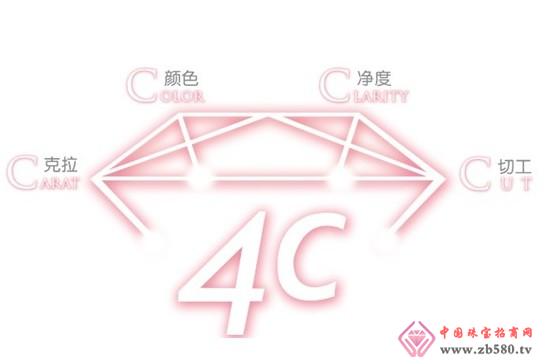Diamond 4C classification instructions
For a finished diamond, it is graded internationally using the 4C standard. This 4C includes: Color, Caratage, Clarity, and Cut. The 4C standard has a direct impact on the quality level of finished diamonds.

Color: In the color evaluation, we mainly grade the colorless-light yellow series diamonds of the Cape series. The grading standards currently used are mainly based on the standards of CIBJO (International Jewelry Federation) and CTIA (American Gemological Institute). There is a difference between them: the color stones in the CTBJO lab are called “standard color stonesâ€, each of which has a lower limit for each color level; the color stone used in the GIA system, each diamond It represents the upper limit of each color level from E days.
With a standard color stone, we have the right light source (colorimetric light), a suitable grading environment (using a standard light source in a dark room) and a wealth of experience, we can The color is graded.
Weight: The international karat shows that the weight of the stone and the weight of the diamond have a direct impact on the price of the diamond. If all other factors of the finished diamond are the same, then the higher the weight of the diamond, the higher the price. In the diamond industry, the price of a diamond is expressed in terms of how much per carat. For diamonds with a certain weight, the price can be quoted at the same price per carat. For diamonds above this range, the price per carat is different. For unset diamonds, the weight is usually weighed by carat or balance; for diamonds that have been inlaid, the weight is usually measured by changing the mark.
Clarity rating:
(1) Preparation before grading:
a. Clean the diamond: scrub the diamond with alcohol and a cloth that is not easily fluffy. The cleaned diamonds should not be used for touching. They should be clipped with tweezers.
b. Observe with a 10x magnifying glass or a 10x stereo binocular microscope.
c. Lighting conditions: usually use colorimetric lights or eye lights when grading.
(2) Division of diamond clarity level:
The clarity of the diamond is divided into LC (no flaw in the mirror); VVS (very micro-level), which is divided into two sub-level VVS, and VVS2 (viewing size); VS level (micro-level) And two sub-levels VS, and VS2; SI level (small level) and two sub-level SI, and SI2; P level (unclear) and three sub-levels P1, P2 and P3 (visible to the naked eye, press Location and size).
(3) Factors affecting the clarity of diamonds:
a. the number of inclusions;
b. the size of the inclusion;
c. the location of the inclusions;
d. the brightness of the inclusions;
e. the type of inclusion;
In the clarity class, we not only observe the internal features of the diamond, but also some natural and artificial external features. For example, the original crystal face, growth pattern, polishing line and damage. These also affect the clarity level of the diamond.
Cut grading: In the cut grading, we mainly classify round multi-faceted ç¢ type diamonds according to strict proportions. For fancy ç¢ type, we can also cut and classify, but due to the abnormal shape, only approximate estimation is made.
The standards for diamond cutting and grading are slightly different in different countries, which is mainly related to people's aesthetic views. In China, the cut ratio of diamonds is: the ratio of platform to width is 56 to 66%, the pavilion depth is moderate to 41 to 45%, and the crown angle is moderate to 31 to 37.
There are three cases in diamond cuts that are clearly cut diamonds. They are:
a. "Fisheye" diamond: Because the pavilion of the diamond is too shallow, the light leaks from the pavilion and cannot be produced.
b. "Block" diamond: Since the pavilion of the diamond is too deep, the light cannot be reflected to the countertop, and the diamond looks black and bright.
c. "Thin" diamonds: There are two reasons for this. One is that the proportion of the countertop is correct, but the crown angle is too small; the other is that the countertop is too large and the crown is shallow. The diamond looks thin overall, is not easy to set, and has a poor fire.
When observing the cut, we must observe the following points: (1) platform width, (2) pavilion depth ratio, (3) crown angle and pavilion angle, (4) lumbar edge degree, (5) polishing line, (6) ) extra facets and so on. A well-cut diamond, the fire is very strong, a little moving and radiant.
At this point, the classification of natural diamonds has been completed. But we must not only accurately classify natural diamonds, but also identify imitations and optimized treatments that are mixed in natural diamonds.
Gold Taffeta Fabric,Silver Taffeta Fabric,PA Silver Taffeta Fabric,W/R PA Silver Taffeta Fabric
CHANGXING HUALONG SILK CO.,LTD , https://www.cxhualongtextile.com